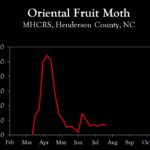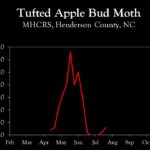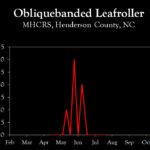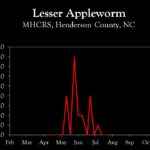WNC Orchard Insect Pest Populations – July 25, 2024
go.ncsu.edu/readext?1015625
en Español / em Português
El inglés es el idioma de control de esta página. En la medida en que haya algún conflicto entre la traducción al inglés y la traducción, el inglés prevalece.
Al hacer clic en el enlace de traducción se activa un servicio de traducción gratuito para convertir la página al español. Al igual que con cualquier traducción por Internet, la conversión no es sensible al contexto y puede que no traduzca el texto en su significado original. NC State Extension no garantiza la exactitud del texto traducido. Por favor, tenga en cuenta que algunas aplicaciones y/o servicios pueden no funcionar como se espera cuando se traducen.
Português
Inglês é o idioma de controle desta página. Na medida que haja algum conflito entre o texto original em Inglês e a tradução, o Inglês prevalece.
Ao clicar no link de tradução, um serviço gratuito de tradução será ativado para converter a página para o Português. Como em qualquer tradução pela internet, a conversão não é sensivel ao contexto e pode não ocorrer a tradução para o significado orginal. O serviço de Extensão da Carolina do Norte (NC State Extension) não garante a exatidão do texto traduzido. Por favor, observe que algumas funções ou serviços podem não funcionar como esperado após a tradução.
English
English is the controlling language of this page. To the extent there is any conflict between the English text and the translation, English controls.
Clicking on the translation link activates a free translation service to convert the page to Spanish. As with any Internet translation, the conversion is not context-sensitive and may not translate the text to its original meaning. NC State Extension does not guarantee the accuracy of the translated text. Please note that some applications and/or services may not function as expected when translated.
Collapse ▲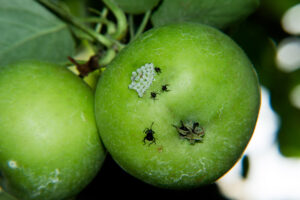 Based on degree-day (DD) accumulations, we remain about 10 to 14 days ahead of last year in terms of insect development. The codling moth DD model predicts that 60% of second generation adults have emerged in Henderson County (about 2100 ft elevation), while adult emergence in Cleveland County (850 ft elevation) is complete. Hence, if not using pheromone traps to monitor populations, it may be wise to assume that a spray is needed.
Based on degree-day (DD) accumulations, we remain about 10 to 14 days ahead of last year in terms of insect development. The codling moth DD model predicts that 60% of second generation adults have emerged in Henderson County (about 2100 ft elevation), while adult emergence in Cleveland County (850 ft elevation) is complete. Hence, if not using pheromone traps to monitor populations, it may be wise to assume that a spray is needed.
While not much has been mentioned of oriental fruit moth (OFM) in recent weeks, third generation adults are active at this time. Populations of this pest have been quite low in recent years, due to use of mating disruption and/or increased use of pyrethroids targeting BMSB in August. As with codling moth, the best approach to detecting potentially damaging populations is monitoring with pheromone traps.
First generation brown marmorated stink bug adult emergence is about 35% complete in Cleveland County and orchards at similar elevations, where 885 DD have accumulated. While numbers have been low up to this point, populations can vary considerably from orchard to orchard. In Henderson County, where 682 DD have accumulated, initial emergence of first generation adults (745 DD) is predicted to begin on August 1.
Insecticides recommended for brown marmorated stink bug on apples:
| INSECTICIDE | PHI (days) | RELATIVE EFFICACY (1=poor, 5=excellent) | RATE/ACRE | MAX PER SEASON |
| Pyrethroids | ||||
| Baythroid (beta-cyfluthrin) | 7 | 4 | 2.4 fl oz | 2.8 fl oz |
| Brigade (bifenthrin)* | 14 | 5 | 9.6 fl oz | 28.8 fl oz |
| Danitol (fenpropathrin) | 14 | 4 | 20 fl oz | 42.6 fl oz |
| Karate/Warrior (lambda-cyhalothrin) | 21 | 4 | 2.5 fl oz | 12.8 fl oz |
| Mustang Maxx (zeta-cypermethrin) | 14 | 4 | 4 fl oz | 24 fl oz |
| Proaxis (gamma-cyhalothrin) | 21 | 4 | 5.1 fl oz | 20.8 fl oz |
| Tombstone (cyfluthrin) | 7 | 4 | 2.4 fl oz | 12.8 fl oz |
| Neonicotinoids | ||||
| Actara (thiamethoxam) | 35 | 4 | 4.5 oz | 16.5 oz |
| Belay (chlothianidin) | 7 | 4 | 6 fl oz | 12 fl oz |
| Premixes | ||||
| Besiege (chlorantraniliprole + lamda-cyhalothrin) | 21 | 4 | 10 fl oz | 31 fl oz |
| Endigo (lamda-cyhalothrin + thiamethoxam) | 35 | 4 | 6 fl oz | 28 fl oz |
| Leverage (imidacloprid + beta-cyfluthrin) | 7 | 4 | 2.8 fl oz | 2.8 fl oz |
| Voliam Flexi (chlorantraniliprole + thiamethoxam) | 35 | 4 | 6 fl oz | 16 fl oz |
| *Brigade is the only bifenthrin product with apple on the label. | ||||
Learn more about southeastern apple insect pests at the Apple Insect Management page.
2024 Average Weekly Trap Captures
| HENDERSON COUNTY | |||
| Insects per trap | |||
| Jul 8 | Jul 15 | Jul 22 | |
| Codling moth | 0.5 | 3.0 | 2.5 |
| Oriental fruit moth | 12.0 | 14.5 | 14.0 |
| Tufted apple bud moth | 0.0 | 1.0 | 3.0 |
| Redbanded leafroller | 0.0 | 0.0 | 0.0 |
| Obliquebanded leafroller | 0.0 | 0.0 | 0.0 |
| Lesser appleworm | 0.0 | 0.0 | 0.0 |
| Apple maggot (research orchards) | 0.0 | 0.0 | 0.0 |
| Apple maggot (abandoned orchard) | 0.0 | 1.0 | 0.0 |
| Brown marmorated stink bug (commercial) | 0.3 | 0.7 | 0.3 |
| Brown marmorated stink bug (unsprayed research orchard) | 0.0 | 0.0 | 0.0 |
| Spotted tentiform leafminer | 0.0 | 0.0 | 0.0 |
| Dogwood borer | 42.0 | 38.0 | 33.0 |
| Peachtree borer | 1.0 | 10.0 | 20.0 |
| Lesser peachtree borer | 5.0 | 1.0 | 3.0 |
| San Jose scale | 66.5 | 17.5 | 5.0 |
*Note that these averages illustrate only the timing of insect emergence and fluctuations in populations, and are not representative of population levels in any given orchard. The only way to have an accurate assessment of an individual orchard’s populations is to set up traps in that orchard.
2024 Accumulated Degree Days
| HENDERSON COUNTY | ||||
| Jul 8 | Jul 15 | Jul 22 | ||
| Codling moth (Biofix: April 15) | 1483 | 1665 | 1834 | |
| Oriental fruit moth (Biofix: March 15) | 2176 | 2393 | 2597 | |
| Tufted apple bud moth (Biofix: April 15) | 1882 | 2099 | 2303 | |




